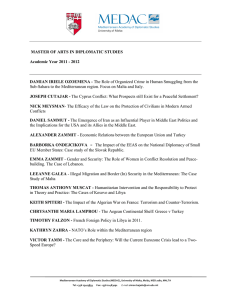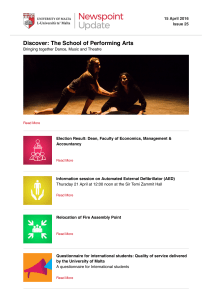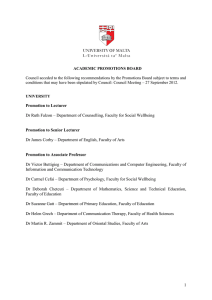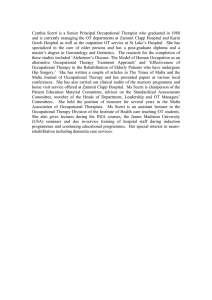missing experiments Journal of Maltese History H.V. Wyatt,
advertisement
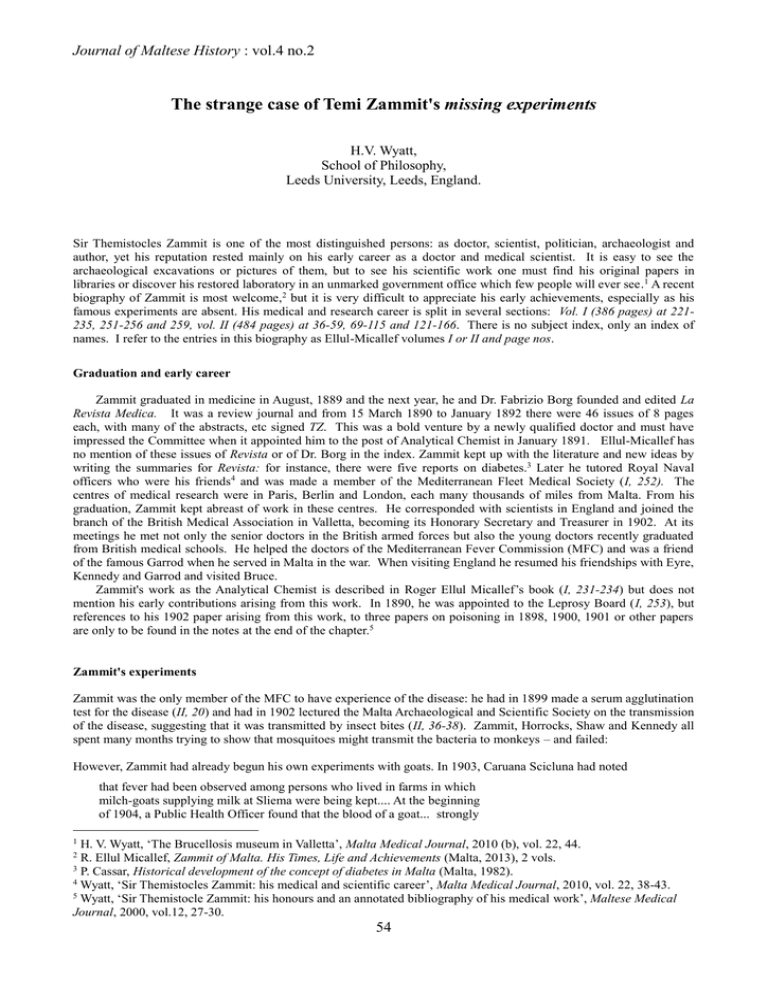
Journal of Maltese History : vol.4 no.2 The strange case of Temi Zammit's missing experiments H.V. Wyatt, School of Philosophy, Leeds University, Leeds, England. Sir Themistocles Zammit is one of the most distinguished persons: as doctor, scientist, politician, archaeologist and author, yet his reputation rested mainly on his early career as a doctor and medical scientist. It is easy to see the archaeological excavations or pictures of them, but to see his scientific work one must find his original papers in libraries or discover his restored laboratory in an unmarked government office which few people will ever see.1 A recent biography of Zammit is most welcome,2 but it is very difficult to appreciate his early achievements, especially as his famous experiments are absent. His medical and research career is split in several sections: Vol. I (386 pages) at 221235, 251-256 and 259, vol. II (484 pages) at 36-59, 69-115 and 121-166. There is no subject index, only an index of names. I refer to the entries in this biography as Ellul-Micallef volumes I or II and page nos. Graduation and early career Zammit graduated in medicine in August, 1889 and the next year, he and Dr. Fabrizio Borg founded and edited La Revista Medica. It was a review journal and from 15 March 1890 to January 1892 there were 46 issues of 8 pages each, with many of the abstracts, etc signed TZ. This was a bold venture by a newly qualified doctor and must have impressed the Committee when it appointed him to the post of Analytical Chemist in January 1891. Ellul-Micallef has no mention of these issues of Revista or of Dr. Borg in the index. Zammit kept up with the literature and new ideas by writing the summaries for Revista: for instance, there were five reports on diabetes.3 Later he tutored Royal Naval officers who were his friends4 and was made a member of the Mediterranean Fleet Medical Society (I, 252). The centres of medical research were in Paris, Berlin and London, each many thousands of miles from Malta. From his graduation, Zammit kept abreast of work in these centres. He corresponded with scientists in England and joined the branch of the British Medical Association in Valletta, becoming its Honorary Secretary and Treasurer in 1902. At its meetings he met not only the senior doctors in the British armed forces but also the young doctors recently graduated from British medical schools. He helped the doctors of the Mediterranean Fever Commission (MFC) and was a friend of the famous Garrod when he served in Malta in the war. When visiting England he resumed his friendships with Eyre, Kennedy and Garrod and visited Bruce. Zammit's work as the Analytical Chemist is described in Roger Ellul Micallef’s book (I, 231-234) but does not mention his early contributions arising from this work. In 1890, he was appointed to the Leprosy Board (I, 253), but references to his 1902 paper arising from this work, to three papers on poisoning in 1898, 1900, 1901 or other papers are only to be found in the notes at the end of the chapter.5 Zammit's experiments Zammit was the only member of the MFC to have experience of the disease: he had in 1899 made a serum agglutination test for the disease (II, 20) and had in 1902 lectured the Malta Archaeological and Scientific Society on the transmission of the disease, suggesting that it was transmitted by insect bites (II, 36-38). Zammit, Horrocks, Shaw and Kennedy all spent many months trying to show that mosquitoes might transmit the bacteria to monkeys – and failed: However, Zammit had already begun his own experiments with goats. In 1903, Caruana Scicluna had noted that fever had been observed among persons who lived in farms in which milch-goats supplying milk at Sliema were being kept.... At the beginning of 1904, a Public Health Officer found that the blood of a goat... strongly H. V. Wyatt, ‘The Brucellosis museum in Valletta’, Malta Medical Journal, 2010 (b), vol. 22, 44. R. Ellul Micallef, Zammit of Malta. His Times, Life and Achievements (Malta, 2013), 2 vols. 3 P. Cassar, Historical development of the concept of diabetes in Malta (Malta, 1982). 4 Wyatt, ‘Sir Themistocles Zammit: his medical and scientific career’, Malta Medical Journal, 2010, vol. 22, 38-43. 5 Wyatt, ‘Sir Themistocle Zammit: his honours and an annotated bibliography of his medical work’, Maltese Medical Journal, 2000, vol.12, 27-30. 1 2 54 Journal of Maltese History : vol.4 no.2 reacted to Remittent fever'. In June 1904, a family of five fell seriously ill after drinking goats' milk6 On 13 September 1904 Zammit and Caruana Scicluna went to an area known as Chadwick Lakes near Mdina to search for suspected cases of malaria. They would have travelled together in the train from Valletta and then by horse carriage. On their return, Horrocks wrote to Bruce that 'Zammit....is attempting to infect goats by feeding'. Zammit and Caruana Scicluna returned to the same location on 14 and 16 September, but on the 15 th, Zammit bought a white goat which was negative when tested for Malta Fever. I have suggested that on that long day together, Caruana Scicluna had talked to Zammit about the connections of goats and fevers and that Zammit then decided to test if goats were susceptible and sometimes transmitting the disease to humans. He infected his white goat which then showed a positive agglutination test, but remained healthy. He bought another goat with the same result, and then bought a kid, no doubt intending to see if it would be infected by suckling from either of his infected milch-goats. At first, his goats were housed on the first floor landing of the public health building, but in the spring of 1905 he made a small laboratory at the Lazaretto on Manoel Island where he took his three goats. Bruce made a short visit to Malta, but before leaving on 12 June, he met the members of the Malta Fever Commission [MFC]. Zammit said that he thought that goats might be involved in transmitting the disease and wanted to buy six new goats. This was resisted by Bruce and Horrocks, but they finally allowed Zammit to buy his goats. Shaw said nothing about his own experiment with infecting a goat.7 On 14 June Zammit tested all his goats, using his two infected goats as positive controls and the kid as a negative. To everyone's surprise, at first five and then all six of his new goats were positive for the bacteria: it was possible that many goats were infected and a source of the disease. In the excitement of the discovery, Zammit wrote a terse account for the Royal Society, examined other goats, but did not publish his findings of his two experimental goats. It was left to Eyre to report that Zammit had found, before 14 June, the bacteria of the disease in the blood, urine and milk of his two experimental goats.8 Zammit's finding of the positive goats was unexpected, but not an accident! Ellul-Micallef does not mention Zammit's experiments with his goats and ignores his testing of his three experimental goats on 14 June, only mentioning the six new goats. He, however, devotes three pages to 'a shortage of monkeys' and two pages to Shaw, Kennedy and other members of the MFC (II, 82-86). Ellul-Micallef has written a good account of the work of the MFC – but without the crucial experiments of Zammit. Bruce used his reputation to exaggerate his own role and ignore Zammit's contribution, while bolstering the reputation of the R.A.M.C. 9 Ellul-Micallef has, sadly, ignored Zammit's experiments and simply attributed the 'most important contributions....by Temi Zammit and Horrocks.' 'Temi's contribution [the examination of the blood of six goats] as detailed by Horrocks' (II, 93)’. This is absurd: Zammit was a careful worker and had already tested his experimental goats and used the two milch goats as positive, with the kid as negative controls. Horrocks was a military officer and used his rank to claim credit for the work of those under him. Zammit's experiments would inevitably have led to the discovery that goats were the principal source of the disease: he was the foremost researcher of the MFC 10 and was its longest member (see Figure A.). Ellul-Micallef has given copious details of many minor characters in his chapter notes, but gives only a couple of references to any works about Zammit since his death. He has given us a background to the history of brucellosis in Malta and the work of the Commission, but without the biography of Zammit's early career. Paul Cassar's booklet is a more interesting account of the Malta Fever story.11 Wyatt, ‘How Themistocle Zammit found that Malta Fever (Brucellosis) to be transmitted by the milk of goats’, Journal of the Royal Society for Medicine, 2015, vol.98, 451-54; ‘Dr G..Caruana Scicluna,’ Journal of Medical Biography, 2000, vol.8, 191-93. 7 Wyatt,’Power presentation of the discovery of the transmission of brucellosis’ available at http://sites.google.com/site/vivianwyatt/ 8 J.W.H. Eyre, The Milroy Lectures on Melitensis septicaemia (Malta or Mediterranean Fever): Lecture III’, Lancet, 1908, vol.1, 1826-832. 9 Wyatt, ‘How did Sir David Bruce forget Zammit and his goats?’, Journal of Maltese History, 2015, vol.4 (1), 39-44. 10 Wyatt, ‘Lessons from the history of Brucellosis’, in G..E.Plumb, G..Pappas, S.C. Olsen eds., Brucellosis: recent developments towards One Health (World Organisation for Animal Health), 2013, vol.32 (1), 17-25. 11 P. Cassar, Sir Themistocles Zammit and the controversy on the goat’s role in the transmission of brucellosis (Mediterranean Fever) 1909-1916 (Malta, 1981). 6 55 Journal of Maltese History : vol.4 no.2 Fig: A: Length of stay in Malta by the members of the Mediterranean Fever Commission. References 56
